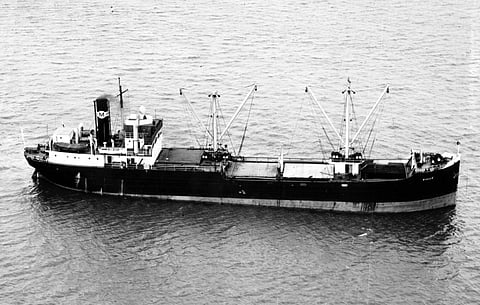

If you remember what a tonnage hatch was, you are probably coasting along to retirement, or to put it politely, in the autumn of your life. To refresh your memory, it was a small hatch on the afterdeck of a shelter-decked ship, and it appeared to have no purpose other than as a useful place to stow things you didn't want cluttering up the decks. I have memories of the bits of the portable swimming pool, a gangway brow, and even the painting punt being stuffed into this space on our ships.
Its purpose, however, was wholly financial and hedged around with all sorts of technical regulations about closing appliances and the dimensions of the coamings, all combining to make the whole of the upper tweendeck, nearly the full length of the ship, not liable for the dues paid on the ship's gross tonnage. It was a wonderful wheeze, which went all the way back to the first power-driven ships in the 19th century, and you can imagine port authorities gnashing their teeth over the years at the harbour, towage, or other dues that the cunning shipowner would not be paying them.
Tonnage measurement, by the late 1960s, had become an arcane branch of ship science; indeed, some likened it to an incomprehensible school of philosophy, whose naval architect practitioners were only able to communicate with each other, but not the wider world. There were specialist designers in this mould who could design ships to a precise tonnage "paragraph", enabling the maximum cargo to be lifted without the need for another half-dozen crew members, or a radio officer, or extra horsepower in the engine. Coasters and short sea ships in particular invariably were found to be 1,499 tons, or 499 tons or such like, demonstrating the cunning skill of these shipwrights.
Scandinavian designers were dab hands at tonnage "cheating" ships. I was aboard a new Norwegian tanker, of all things, which claimed to have a tweendeck, so that one third of the cargo space was free from tonnage dues. It turned out to be a longitudinal stringer, about a foot wide, running through the tanks, but somehow satisfied the regulators of its veracity. I remember a small heavy lift ship where the master told me he lived in the wheelhouse because his cabin was not much bigger than a broom cupboard – "because of the tonnage rules".
Some of what the designers tried to get away with were crazy. There were Ro-Ro owners claiming that all the underdeck space was a "shelter deck" and thus they didn't have any gross tonnage at all. Port operators, in particular, were tearing their hair out. Containerships with all that unregistered and unchargeable cargo on deck drove them mad.
There were also some very dangerous designs. There were Ro-Ros where the main cargo deck was under the load waterline, with the sea kept out by a sort of hump, with the stern door open. There were innumerable losses over the years of "raised shelterdeck" coasters, where the forward hold was lower than the rest of the ship and could be easily stove in by boarding seas. There was assort of "never mind seaworthiness – think of the dues we save" attitude, which was, if you think about it, fairly reprehensible.
The 1969 Tonnage Measurement Convention was supposed to do away with all this nonsense and produce internationally acceptable rules for ship measurement that would be fair and reasonable. This, of course, was easier said than done, with every conceivable "user" of tonnage coming up with ideas that favoured their own particular needs. Those on the paying side – the ship operators – were anxious not to pay a cent extra, while those on the receiving side of these dues, such as the ports, were desperate to stop the owners getting away with murder. And anyone with any sense wanted to ensure that even dafter designs did not result from creative naval architecture.
After a couple of years of preparation, the conference to end all tonnage measurement nonsense took place at Church House, Westminster, in 1969, lasting for almost three weeks at which all sorts of adventurous solutions were proposed, rejected, and argued about for hours. Endless time was spent on how existing, as opposed to new, ships should be treated – should they all be re-measured and if so, how could this be done without disadvantaging them?
Huge mathematical formulae were wrestled over by mathematicians from all around the world, and in the nick of time, after an overnight session on the gigantic Lloyd's Register mainframe computer, they arrived at something that the delegates could agree about. Mind you, that was not the same as implementing the new convention, which took about a decade and a half to come into effect. This allowed the fiendishly clever ship owners to lay down new ships under the old system for years, leading to bits of rusty steel lying around in shipyards well into the 1980s as they were in no hurry to complete them.
But the tonnage system we have today was devised at this meeting and most will agree it is probably better than what it replaced, although there remain serious anomalies. However, by the time it came into effect lots of "users" of tonnage, such as the ports, had decided that they would charge a ship, not for its gross tonnage, but for the area of the port it occupied – and all of a sudden it was the length that was more important. That was a new challenge for the designers! But that is another story.
Submissions wanted! Do you have an exciting, amusing or downright dangerous anecdote from your time in the maritime world? Each week, we will feature new personal experiences from across the globe. Submissions to: editor@bairdmaritime.com.
